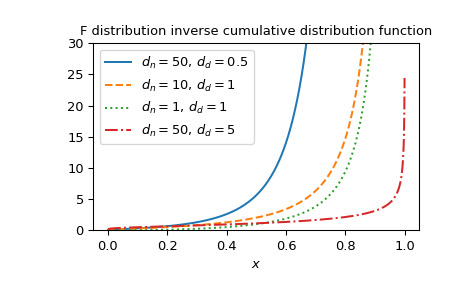本文简要介绍 python 语言中 scipy.special.fdtri 的用法。
用法:
scipy.special.fdtri(dfn, dfd, p, out=None) = <ufunc 'fdtri'>#F-distribution 的 p-th 分位数。
该函数是 F-distribution CDF 的逆函数,
fdtr,返回x这样fdtr(dfn, dfd, x) = p.- dfn: array_like
第一个参数(正浮点数)。
- dfd: array_like
第二个参数(正浮点数)。
- p: array_like
累积概率,在 [0, 1] 中。
- out: ndarray,可选
函数值的可选输出数组
- x: 标量或 ndarray
p 对应的分位数。
参数 ::
返回 ::
注意:
使用与反正则化 beta 函数 的关系进行计算。让然后,
如果p是这样的,使用以下关系来提高稳定性:让然后,
Cephes [1] 例程的包装器
fdtri。F 分布也可用作
scipy.stats.f。与scipy.stats.f的ppf方法相比,直接调用fdtri可以提高性能(请参见下面的最后一个示例)。参考:
[1]Cephes 数学函数库,http://www.netlib.org/cephes/
例子:
fdtri表示 F 分布 CDF 的倒数,可表示为fdtr。在这里,我们计算 CDFdf1=1,df2=2在x=3.fdtri然后返回3给定相同的值df1,df2和计算的 CDF 值。>>> import numpy as np >>> from scipy.special import fdtri, fdtr >>> df1, df2 = 1, 2 >>> x = 3 >>> cdf_value = fdtr(df1, df2, x) >>> fdtri(df1, df2, cdf_value) 3.000000000000006通过为 x 提供 NumPy 数组来计算多个点的函数。
>>> x = np.array([0.1, 0.4, 0.7]) >>> fdtri(1, 2, x) array([0.02020202, 0.38095238, 1.92156863])绘制多个参数集的函数。
>>> import matplotlib.pyplot as plt >>> dfn_parameters = [50, 10, 1, 50] >>> dfd_parameters = [0.5, 1, 1, 5] >>> linestyles = ['solid', 'dashed', 'dotted', 'dashdot'] >>> parameters_list = list(zip(dfn_parameters, dfd_parameters, ... linestyles)) >>> x = np.linspace(0, 1, 1000) >>> fig, ax = plt.subplots() >>> for parameter_set in parameters_list: ... dfn, dfd, style = parameter_set ... fdtri_vals = fdtri(dfn, dfd, x) ... ax.plot(x, fdtri_vals, label=rf"$d_n={dfn},\, d_d={dfd}$", ... ls=style) >>> ax.legend() >>> ax.set_xlabel("$x$") >>> title = "F distribution inverse cumulative distribution function" >>> ax.set_title(title) >>> ax.set_ylim(0, 30) >>> plt.show()
F 分布也可用作
scipy.stats.f。直接使用fdtri比调用scipy.stats.f的ppf方法要快得多,特别是对于小型数组或单个值。为了获得相同的结果,必须使用以下参数化:stats.f(dfn, dfd).ppf(x)=fdtri(dfn, dfd, x)。>>> from scipy.stats import f >>> dfn, dfd = 1, 2 >>> x = 0.7 >>> fdtri_res = fdtri(dfn, dfd, x) # this will often be faster than below >>> f_dist_res = f(dfn, dfd).ppf(x) >>> f_dist_res == fdtri_res # test that results are equal True
相关用法
- Python SciPy special.fdtridfd用法及代码示例
- Python SciPy special.fdtrc用法及代码示例
- Python SciPy special.fdtr用法及代码示例
- Python SciPy special.factorial用法及代码示例
- Python SciPy special.fresnel用法及代码示例
- Python SciPy special.factorial2用法及代码示例
- Python SciPy special.factorialk用法及代码示例
- Python SciPy special.exp1用法及代码示例
- Python SciPy special.expn用法及代码示例
- Python SciPy special.ncfdtri用法及代码示例
- Python SciPy special.gamma用法及代码示例
- Python SciPy special.y1用法及代码示例
- Python SciPy special.y0用法及代码示例
- Python SciPy special.ellip_harm_2用法及代码示例
- Python SciPy special.i1e用法及代码示例
- Python SciPy special.smirnovi用法及代码示例
- Python SciPy special.ker用法及代码示例
- Python SciPy special.ynp_zeros用法及代码示例
- Python SciPy special.k0e用法及代码示例
- Python SciPy special.j1用法及代码示例
- Python SciPy special.logsumexp用法及代码示例
- Python SciPy special.expit用法及代码示例
- Python SciPy special.polygamma用法及代码示例
- Python SciPy special.nbdtrik用法及代码示例
- Python SciPy special.nbdtrin用法及代码示例
注:本文由纯净天空筛选整理自scipy.org大神的英文原创作品 scipy.special.fdtri。非经特殊声明,原始代码版权归原作者所有,本译文未经允许或授权,请勿转载或复制。
